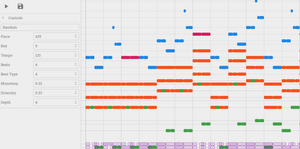Information
- Publication Type: Master Thesis
- Workgroup(s)/Project(s):
- Date: April 2021
- Date (Start): 2019
- Date (End): April 2021
- TU Wien Library:
- Second Supervisor: Martin Ilčík

- Diploma Examination: 18. May 2021
- Open Access: yes
- First Supervisor: Michael Wimmer

- Pages: 128
- Keywords: procedural, music, composition, functional, context-free, probabilistic, temporal, parametric, attribute-based, grammars
Abstract
We present a theoretical framework for automatic music composition with formal grammars and a focus on polyphonic structures. In the context of this thesis, a polyphonic structure is any arrangement of musical entities (notes, chords, measures, etc.) that is not purely sequential in the time dimension. Given that the natural output of a grammar is a sequence, the generation of sequential structures, such as melodies, harmonic progressions, and rhythmic patterns, follows intuitively and has already been explored in prior works. By contrast, we associate each musical entity with an independent temporal scope, allowing the representation of both sequential and parallel arrangements. With overlapping entities we can model chords, drum patterns, and parallel voices---polyphony on small and large scales. Beyond a foundational discussion of functional techniques for polyphonic composition with non-deterministic context-free grammars, we demonstrate the implementation and practical application of an automated composition system developed on these principles.
Additional Files and Images
Additional images and videos
Additional files
Weblinks
BibTeX
@mastersthesis{eibensteiner-2021-pmcg,
title = "Polyphonic music composition with grammars",
author = "Lukas Eibensteiner",
year = "2021",
abstract = "We present a theoretical framework for automatic music
composition with formal grammars and a focus on polyphonic
structures. In the context of this thesis, a polyphonic
structure is any arrangement of musical entities (notes,
chords, measures, etc.) that is not purely sequential in the
time dimension. Given that the natural output of a grammar
is a sequence, the generation of sequential structures, such
as melodies, harmonic progressions, and rhythmic patterns,
follows intuitively and has already been explored in prior
works. By contrast, we associate each musical entity with an
independent temporal scope, allowing the representation of
both sequential and parallel arrangements. With overlapping
entities we can model chords, drum patterns, and parallel
voices---polyphony on small and large scales. Beyond a
foundational discussion of functional techniques for
polyphonic composition with non-deterministic context-free
grammars, we demonstrate the implementation and practical
application of an automated composition system developed on
these principles.",
month = apr,
pages = "128",
address = "Favoritenstrasse 9-11/E193-02, A-1040 Vienna, Austria",
school = "Research Unit of Computer Graphics, Institute of Visual
Computing and Human-Centered Technology, Faculty of
Informatics, TU Wien",
keywords = "procedural, music, composition, functional, context-free,
probabilistic, temporal, parametric, attribute-based,
grammars",
URL = "https://www.cg.tuwien.ac.at/research/publications/2021/eibensteiner-2021-pmcg/",
}

 poster
poster thesis
thesis


